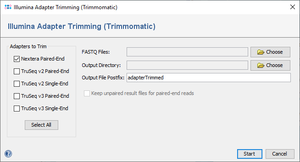The presence of adapter sequences in next-generation sequencing (NGS) data significantly reduces the quality of assembling and other downstream analysis results. Therefore, in SeqSphere+ the software Trimmomatic (citation) can be used to perform a trimming of Illumina adapter sequences in FASTQ read data.
The dialog window for adapter trimming can be invoked via the menu function Tools | Genome Utilities | Illumina Adapter Trimming (Trimmomatic).
In the left part of the dialog the available adapter sequences are listed. The Illumina adapter sequences for Nextera and TruSeq library prep kits are distributed together with Trimmomatic.
Multiple or even all adapter sequences can be selected at once. The following adapter sequences are provided:
- Nextera Paired-End (default)
- TruSeq v2 Paired-End
- TruSeq v2 Single-End
- TruSeq v3 Paired-End
- TruSeq v3 Single-End
The dialog window has the following further fields/options:
- FASTQ Files
- One FASTQ file (single-end) or two FASTQ files (paired-end) that should be trimmed must be selected here.
- Output Directory
- The directory where to store the trimmed FASTQ files must be selected here.
- Output File Postfix
- A postfix that is appended to the name of the trimmed FASTQ files can be defined here.
- Keep unpaired result files for paired-end reads
- For paired-end data reads that have no corresponding read in the FASTQ file of the other direction are removed from the trimmed FASTQ files. If this option is enabled, those reads are kept in an extra FASTQ file with the postfix "_Unpaired". This option is only enabled if two FASTQ files were selected as input.
After Trimmomatic has finished a message dialog is shown. The button Show FASTQ Statistics in this dialog can be used to show the statistics (e.g., base count) for the input files and all created output files.



